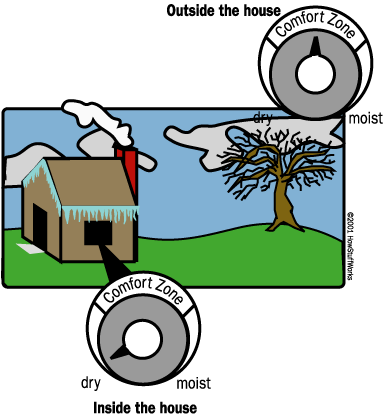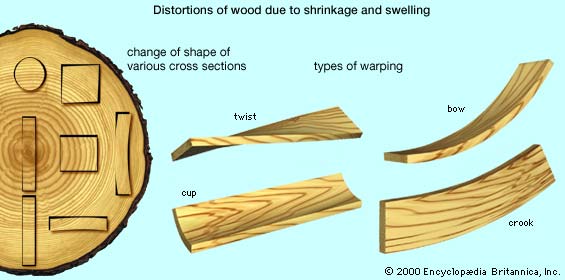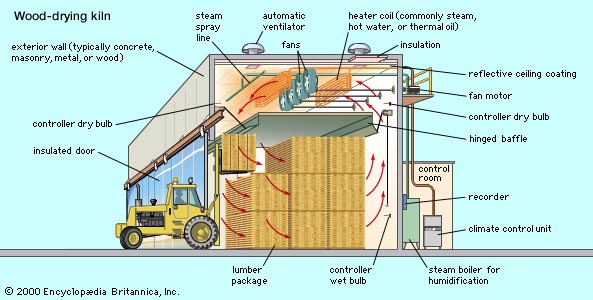


|
Wood Drying| Sawmill Tour | Wood Drying | Wood Catalog | This section, as with most of our educational pages, is being built and growing in time. Keep checking back as we'll expand it whenever we have a moment and a new tidbit! The study of drying wood, moisture contents, finishing, and how to apply these concepts to furniture making fills volumes of books. Our goal here is to condense enough of the basics down to a few web pages and provide our clients a basic working knowledge. Moisture Content of Wood The moisture content of wood is measured as the ratio of the weight of water in a given piece of wood, to the weight of wood when it is completely dry (or "oven dry") and is usually expressed as a percentage. Wood destined to become lumber is deemed as "green" when the tree is first felled. A freshly felled tree may have a moisture content anywhere in the range 30% to over 200%, depending on the species. Logs go through a series of steps that take them either through an aging period or directly into the sawmill. After milling the goal is to remove almost all of the moisture content to stabilize the material. Air drying lumber is one method, but this generally takes years to complete and the net result is commonly considered unsuitable for use as material for furniture. Kiln The desired moisture content depends upon the intended use, and also upon the annual average relative humidity at the place where the wood is to be used. Wood is a cellulose material which behaves somewhat like a sponge, so that even wood which has been "kiln dried" down to 7% (a typical value for furniture use) may in fact later reabsorb water from the atmosphere. Wood is almost alive throughout its functional use, constantly gaining or losing water to or from the environment depending on all sorts of conditions including its final finish. The moisture content of wood changes as the relative humidity changes. In other words - nothing can actually change in the wood itself but by the humidity around the material changing - the moisture content within the wood compared to the moisture content of the surrounding air changes. This condition can create an imbalance, causing moisture to either tend towards entering or leaving the wood. Ever notice winter to make it feel very dry in your house? Wood "feels" the same way.
For example:Let's say that the outdoor temperature is 0 degrees C, or 32 degrees F. The maximum amount of water that a cubic meter of air can hold at this temperature is 5 grams. Now you bring this cubic meter of air inside and heat it to 25 degrees C or 77 degrees F. The relative humidity is only 23 percent: 5 grams of water in the air / 22 grams possible
= 23 percent relative humidity It gets worse as the temperature outside falls lower. This is why the air inside any heated building in the winter feels so dry. Any time the temperature outside is below freezing, relative humidity inside will be below 20 percent unless you do something to increase the humidity. This low relative humidity will cause furniture to dry out, the moisture in the wood will tend to want to exit the wood to fill the void in the surround air. Think of it like a vacuum witch draws air and whatever else is in the general area to the space with less air pressure. Wherever there is less moisture (in or outside the wood) the moisture will tend to be drawn in this direction to create balance. Within a piece of lumber, the cellular structure of the tree remains. When the moisture content of these cells becomes unevenly distributed, tension is created or released within various locations throughout the plank. As the moisture content of improperly dried or stored wood changes, so does the wood expand or contract, potentially producing all manner of disastrous defects (and hence wood warping nightmares).
Distortions in sawn wood due to shrinkage and swelling At left are shown the initial (dark outlines) and final shapes that may result from differences in radial and tangential shrinkage, depending on the original position of the wood in the tree trunk. Various kinds of warping, at right, may result from differential shrinkage and swelling or from differences in the distribution of moisture content in the wood. Why Wood Warps This tree cross-section shows the distortion of flat, square, and round wood as affected by the direction of the annual growth rings. The clear space surrounding each wood section is the shrinkage in drying from green to oven dry condition. Wood undergoes dimensional changes when its moisture fluctuates below the fibre saturation point. Loss of moisture results in shrinkage, and gain in swelling. It is characteristic that these dimensional changes are anisotropic-different in axial, radial, and tangential directions. Average values ...
Moisture Content & Wood OD = Oven Dry, KD = Typical Kiln Dried, AD = Air Dried. Bound Water is contained within the wood cells; Free Water exists in the spaces in between the wood cells. At the Fiber Saturation Point (FSP) the wood attains its maximum possible amount of bound water.
Relative Humidity & Wood EMC Equilibrium Moisture Content (EMC) of wood is the moisture content which will eventually be attained by any piece of wood, when stored indefinitely at a particular relative humidity. For furniture, cabinets, or works of art which will be used indoors, the wood you work with should be dried down to the EMC corresponding to the annual average relative humidity at that location. For most woodworkers across most of North America, 6% to 8% is a good wood moisture content to aim for. Using a Moisture Meter With a wood moisture meter you will have the means to measure and hence control the moisture content of your valuable wood. No more nightmares! <MORE COMING SOON!> The Drying Process <MORE COMING SOON!> Finishing - The Protective Barrier Coats of varnish, oil, shellac, or paint provide a barrier between the cellular structure of the wood and the surrounding environment. This barrier may greatly slow down the function of moisture transfer, but will not stop it completely. The theory is - if the barrier is good enough it creates a delay in the transfer of moisture. This is beneficial for two reasons. 1) If the barrier provides enough time, the relative humidity will change and over time if the "averages" of the moisture level inside the wood vs. the surrounding air are close the wood will remain in balance. 2) The barrier will slow the transfer down enough to give the wood time to balance internally - at least providing a chance that although expansion and contraction may take place ... warping, twisting, or cupping may be avoided. Given an extreme - a finish won't help the forces will prevail. However, in standard conditions a proper finish will drastically increase the functional life of wood furniture. Check our finishing feature pages for more details on the history of and processes for various types of finishes.
|
|||||||||||||||||||||||||||||||||||||||||||||||
| home | company background | woodcarving & sculpture | period furniture custom built-in's | services | commissioning process museum/historical affiliations | educational services | craftsmen links sitemap | search |
||||||||||||||||||||||||||||||||||||||||||||||||
Artisans of the Valley Hand Crafted Custom Woodworking Stanley D. Saperstein Eric M. Saperstein Our studio and showrooms are open by appointment. Please call ahead so we don't miss you! (609) 637-0450 Fax (609) 637-0452 e-mail: woodworkers@artisansofthevalley.com |






